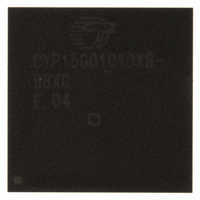CYP15G0101DXB-BBXC Cypress Semiconductor Corp, CYP15G0101DXB-BBXC Datasheet - Page 14

CYP15G0101DXB-BBXC
Manufacturer Part Number
CYP15G0101DXB-BBXC
Description
IC TXRX HOTLINK 100-LBGA
Manufacturer
Cypress Semiconductor Corp
Series
HOTlink II™r
Type
Transceiverr
Specifications of CYP15G0101DXB-BBXC
Package / Case
100-LBGA
Protocol
Fibre Channel
Voltage - Supply
3.135 V ~ 3.465 V
Mounting Type
Surface Mount
Product
PHY
Data Rate
1500 MBd
Supply Voltage (max)
3.465 V
Supply Voltage (min)
3.135 V
Supply Current
0.5 A
Maximum Operating Temperature
+ 70 C
Minimum Operating Temperature
0 C
Mounting Style
SMD/SMT
Number Of Channels
1
Lead Free Status / RoHS Status
Lead free / RoHS Compliant
For Use With
CYP15G0101DX-EVAL - EVAL BRD FOR HOTLINK II
Number Of Drivers/receivers
-
Lead Free Status / Rohs Status
Lead free / RoHS Compliant
Other names
428-2920
CYP15G0101DXB-BBXC
CYP15G0101DXB-BBXC
Available stocks
Company
Part Number
Manufacturer
Quantity
Price
Company:
Part Number:
CYP15G0101DXB-BBXC
Manufacturer:
MURATA
Quantity:
260 000
Company:
Part Number:
CYP15G0101DXB-BBXC
Manufacturer:
CYPRESS
Quantity:
206
Company:
Part Number:
CYP15G0101DXB-BBXC
Manufacturer:
Cypress Semiconductor Corp
Quantity:
10 000
Part Number:
CYP15G0101DXB-BBXC
Manufacturer:
CYPRESS/赛普拉斯
Quantity:
20 000
When the encoder is bypassed, the character captured from the
TXD[7:0] and TXCT[1:0] inputs is passed directly to the transmit
shifter without modification. If parity checking is enabled
(PARCTL LOW) and a parity error is detected, the 10-bit
character is replaced with the 1001111000 pattern (+C0.7
character) regardless of the running disparity of the previous
character.
With the encoder bypassed, the TXCT[1:0] inputs are considered
part of the data character and do not perform a control function
that would otherwise modify the interpretation of the TXD[7:0]
bits. The bit usage and mapping of these control bits when the
encoder is bypassed is shown in
In encoder bypass mode, the SCSEL input is ignored. All
clocking modes interpret the data in the same way.
Table 3. Transmit Operating Modes
Table 4. Encoder Bypass Mode (TXMODE[1:0] = LL)
Document Number: 38-02031 Rev. *L
Note
14. LSB is shifted out first.
TX Mode
0
1
2
3
4
5
6
7
8
TXD[0]
TXCT[1]
Signal Name
TXCT[0]
TXD[1]
TXD[2]
TXD[3]
TXD[4]
TXD[5]
TXD[6]
TXD[7]
MM Atomic
MH
HM
LM
ML
HH
LH
HL
LL
(LSB)
(MSB)
None
None
None
Atomic
Atomic
Interruptible
Interruptible
Interruptible
Word Sync
Sequence
[14]
Support
Bus Weight
None
None
None
Special
Character
Word Sync
None
Special
Character
Word Sync
None
Operating Mode
2
2
2
2
2
2
2
2
2
2
Control
SCSEL
0
1
2
3
4
5
6
7
8
9
Table
4.
Encoder bypass
Reserved for test
Reserved for test
Encoder control
Encoder control
Encoder control
Encoder control
Encoder control
Encoder control
TXCT Function
10B Name
a
b
c
d
e
g
h
i
f
j
TX Modes 1 and 2—Factory Test Modes
These modes enable specific factory test configurations. They
are not considered normal operating modes of the device. Entry
or configuration into these test modes will not damage the
device.
TX Mode 3—Atomic Word Sync and SCSEL Control of Special
Codes
When configured in TX Mode 3, the SCSEL input is captured
along with the TXCT[1:0] data control inputs. These bits combine
to control the interpretation of the TXD[7:0] bits and the
characters generated by them. These bits are interpreted as
listed in
Table 5. TX Modes 3 and 6 Encoding
When TXCKSEL = MID or HIGH, the transmit channel captures
data into its input register using the TXCLK clock.
Word Sync Sequence
When TXCT[1:0] = 11, a 16-character sequence of K28.5
characters, known as a Word Sync Sequence, is generated on
the transmit channel. This sequence of K28.5 characters may
start with either a positive or negative disparity K28.5 (as
determined by the current running disparity and the 8B/10B
coding rules). The disparity of the second and third K28.5
characters in this sequence are reversed from what normal
8B/10B coding rules would generate. The remaining K28.5
characters in the sequence follow all 8B/10B coding rules. The
disparity of the generated K28.5 characters in this sequence
follow a pattern of either + + – – + – + – + – + – + – + – or
– – + + – + – + – + – + – + – +.
When TXMODE[1] = MID (open, TX modes 3, 4 and 5), the
generation
(non-interruptible) operation. Once it has been successfully
started, it cannot be stopped until all 16 characters have been
generated. The content of the input register is ignored for the
duration of this 16-character sequence. At the end of this
sequence, if the TXCT[1:0] = 11 condition is sampled again, the
sequence restarts and remains uninterrupted for the following 15
character clocks.
If parity checking is enabled, the character used to start the Word
Sync Sequence must also have correct ODD parity. This is true
even though the contents of the TXD[7:0] bits do not directly
control the generation of characters during the Word Sync
Sequence. Once the sequence is started, parity is not checked
on the following 15 characters in the Word Sync Sequence.
X
X
0
1
X
0
0
1
Table
0
1
1
1
of
5.
Encoded data character
K28.5 fill character
Special character code
16-character Word Sync Sequence
this
character
Characters Generated
CYW15G0101DXB
CYP15G0101DXB
CYV15G0101DXB
sequence
is
Page 14 of 44
an
atomic
[+] Feedback











